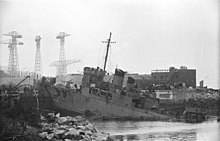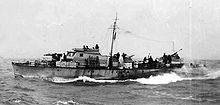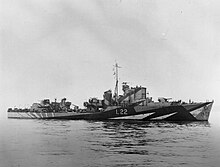HMS Atherstone (L05)
|
The Hunt destroyer Atherstone 1942
|
||||||||||||||||||||
|
||||||||||||||||||||
|
||||||||||||||||||||
|
||||||||||||||||||||
|
||||||||||||||||||||
The HMS Atherstone (L05) was the lead ship of the new escort destroyer of the Hunt class of the British Royal Navy , 20 of which had been ordered yet at peace. During the Second World War , more were ordered in the first war-building programs and a total of 86 Hunt-class destroyers were built, some of which first entered service with the Polish , Norwegian , Greek and Free French navies . When testing the Atherstone , a design flaw in the original design was recognized, so that the Peace Order could not come into use with the planned main armament of three 102 mm twin guns and the third raised gun at the stern was dispensed with. It was removed from the Atherstone and some early sister ships during testing.
The Atherstone served in British coastal waters from 1940 to mid-1943 and came with the Allied landings in Italy to the security forces in the Mediterranean, where she remained in service for the remainder of the war. The post-war period the ship was part of the reserve fleet and in November 1957 the Atherstone was sold for demolition.
History of the ship
The HMS Atherstone was the lead ship for the first order for new destroyer escorts of the Hunt class . In March / April 1939, 20 ships of the new type were ordered from British shipyards. The planning provided for three 102 mm twin guns as the main armament for these ships . However, due to an incorrect calculation, the carrying capacity of the hull of the first series was too low to be able to carry it. So the twenty ships as Type I received only two double guns as bow and stern armament. However, the 2pdr 40 mm Flakvierling was placed on the rear deckhouse instead of the non-installed third 102 mm gun, where the weapon intended for close-range anti-aircraft defense had an excellent fire area. There were also reductions in the superstructure and the funnel to reduce the top weight and ballast was also installed in the fuselage for reasons of stability.
The contract for the construction of the type ship for the new destroyer escort went to Cammell Laird in Birkenhead , where two Hunt destroyers were keeled on June 8, 1939. On this day, the keel-laying of their orders usually took place at the other shipyards involved in the construction program. The Atherstone was launched on December 12, 1939 as one of the first Hunt destroyers. The ship was named a Racecourse-class mine sweeper . Of these 810 ts coasters with side-wheel drive , there were 32 ships.
On the same day as the Atherstone , the Hambledon was launched at Swan Hunter in Wallsend and before the end of the year the HMS Eglinton (L87) was launched at Vickers-Armstrong in Newcastle . Atherstone's
sister ship , HMS Berkeley (L17) , which was ordered at the same time , was launched on January 29, 1941. In August / September 1940, Blencathra and Brocklesby were launched at Cammell Laird; both orders of the first war building program immediately after the start of the war, which already received the improved hulls of the types II and III of the class , but were still armed like type I ships. Cammell Laird also built two other Type II ships ( HMS Badsworth and Beaufort ), which were launched in the first half of 1941, and then four Type III ships, the last pair ( Eskdale and Glaisdale ) being commissioned in the summer of 1942 by the Norwegian Navy took place.
War missions
The ship was first used in the 1st Destroyer Flotilla in Portsmouth . In June / July 1940, further tests were carried out to drive the crew into Scapa Flow at Home Fleet , where the Atherstone escort tasks in the security of arriving evacuation escorts from Norway and mine-laying operations.
In August she returned to the canal flotilla. On September 11, 1940, while convoy CW 11 was escorting to the Thames , she was attacked from the air and suffered severe damage from two direct hits (50 kg) and one close hit (250 kg). Five men of the crew lost their lives in the attack. The ship was repaired in the Navy shipyard in Chatham until January 1941. When the shipyard was idle at the end of 1942 due to bad weather damage, the Atherstone , like many ships used to secure the coastal convoys, received a single 2pdr gun at the bow to improve the defense against speedboats . After the overhaul, the Atherstone moved to the 15th Destroyer Flotilla to Plymouth to secure the south-western access routes to the British Isles.
In the British raid against the so-called Normandy Dock in the port of Saint-Nazaire in March 1942, the Atherstone and the Tynedale were supposed to be the attack force consisting of an old destroyer loaded with explosives ( Campbelltown ), sixteen motor launchers , a motor gunboat and a motor torpedo boat escorted as far as possible to the target under cover of a distracting airstrike. The commando attack was supposed to put the dock out of action as the only repair option in the event of a possible deployment of the Tirpitz in the Atlantic. On the march, the two destroyers escorted a recognized German submarine, brought the unit to a position 65 nautical miles off St. Nazaire on March 27, 1942 by 9:00 p.m. and then remained at sea.
On the morning of the 28th, the waiting Atherstone and Tynedale encountered five German torpedo boats ( white-tailed eagles , polecats , jaguars , falcons , condors ) and opened fire at a distance of over 10 km. The German torpedo boats withdrew after ten minutes. Shortly after the battle, the destroyers escorted the returning MGB 364 and two launches. Atherstone took over the wounded from the boats and the march back began, as no more boats were expected to arrive. Around 9:00 a.m., two more Hunt destroyers arrived from Plymouth to secure the unit, which was discovered shortly afterwards by a Heinkel He 115 and subsequently attacked several times by the Air Force. Despite the air security by Beaufighters and Hudsons , the unit leader decided to sink the motorboats because of the attacks and the heavy seas in order to enable the seriously wounded on board the Atherstone to receive good medical care on land as quickly as possible.
In May 1942, the Atherstone moved to the 16th destroyer flotilla in Sheerness in order to be used on the British east coast in the future. In March 1943 she moved to the 18th Flotilla in the Western Mediterranean, where she was deployed from the Algerian coast. At the beginning of July 1943 she was one of 43 hunt destroyers ( Operation Husky ) used in the Allied landing on the south and south-east coast of Sicily . When the 5th US Army landed in the Bay of Salerno ( Operation Avalanche ) in early September , it was part of the "Support Carrier Force" (TF.88) under Rear Admiral Vian , which was in the landing zone with the light carrier Unicorn , four escort carriers of Attacker class (HMS Battler, Attacker, Hunter, Stalker ), three cruisers of Dido class and eight other Hunt destroyers, including the Polish Ślązak and Krakowiak , the air cover provided,
While the convoy KMF 26 was being secured from Oran to Egypt on November 26, 1943, one day after its departure, an air force unit attacked with a Heinkel He 177 . One of the machines hit the troop transport HMT Rohna with a remote-controlled Henschel Hs 293 , which sank. The minesweeper USS Pioneer and the freighter Clan Campbell dropped back to rescue castaways. The Atherstone was also left behind to fend off any further air raid. The high swell did not allow the use of lifeboats. The rescue ships could accommodate over 1000 castaways, including over 600 the Pioneer and 70 the Atherstone . However, over 1,100 people were also killed, including 1,015 US soldiers.
In early August 1944, the Atherstone was one of 20 Hunt destroyers ( Operation Dragoon ) used to secure the Allied landing in southern France . In November 1944, the destroyer was assigned to the 5th Destroyer Flotilla in Alexandria and mostly used in the Adriatic.
On December 14, 1944, the Atherstone fired at enemy positions on the island of Pag and on the opposite mainland coast with the help of artillery observers on the island and supported by partisans with the Aldenham of the Hunt III type, which was also built at Cammell Laird . On the march back, the Aldenham ran into a mine on the sea side of the island of Pag and sank. 63 men of the crew, including the commanding officer, were rescued from the Atherstone and two coastal defense boats running behind her , 126 men died.
Final fate
The Atherstone remained in the Mediterranean until October 1945 and then returned to Portsmouth and was there for the next eight years as a ship in the reserve fleet. Then she was transferred to Cardiff to the division of the reserve fleet there. In 1957 the ship was offered for sale. In November 1957 the Atherstone was sold for demolition to Smith & Houston in Port Glasgow , where the decommissioned ship arrived in tow on November 25, 1957.
Renewed use of the name
Since January 17, 1987 there is again an HMS Atherstone (M38) in service with the Royal Navy . The third Atherstone is a third -class minehunter that was launched on March 1, 1986 at Vosper Thornycroft in Woolston, Southampton and is now used by the 2nd Mine Countermeasure (MCM) Squadron in Portsmouth.
Individual evidence
- ^ Ford: St. Nazaire 1942: The Great Commando Raid. P. 36.
- ^ Rohwer: Chronicle of the naval war. P. 232.
- ↑ In fact, three launch boats made the return march on their own
- ^ Rohwer, p. 383
- ↑ HMS Aldenham (L 22) on uboatnet
- ↑ HMS Atherstone - www.royal-navy.mod.uk ( Memento of the original from October 25, 2008 in the Internet Archive ) Info: The archive link was inserted automatically and has not yet been checked. Please check the original and archive link according to the instructions and then remove this notice.
literature
- Ken Ford: St. Nazaire 1942: The Great Commando Raid. Osprey Publishing Campaign series N ° 92, Oxford, ISBN 1-84176-231-8 .
- Jürgen Rohwer , Gerhard Hümmelchen : Chronicle of the naval war 1939-1945. Manfred Pawlak VerlagsGmbH, Herrsching 1968, ISBN 3-88199-0097 .








